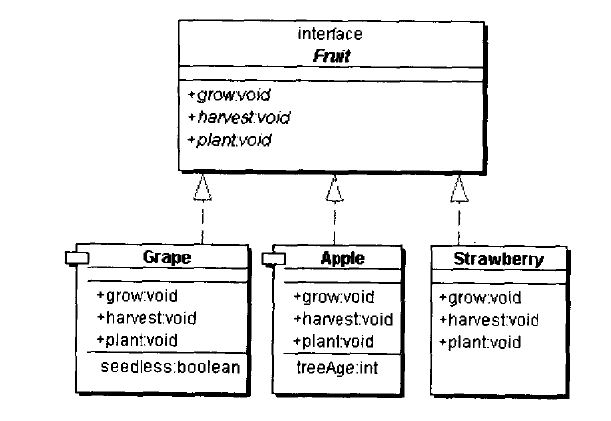工厂模式
工厂模式(Factory Pattern)是 Java 中最常用的设计模式之一。这种类型的设计模式属于创建型模式,它提供了一种创建对象的最佳方式。
在工厂模式中,我们在创建对象时不会对客户端暴露创建逻辑,并且是通过使用一个共同的接口来指向新创建的对象。
介绍
意图:定义一个创建对象的接口,让其子类自己决定实例化哪一个工厂类,工厂模式使其创建过程延迟到子类进行。
主要解决:主要解决接口选择的问题。
何时使用:我们明确地计划不同条件下创建不同实例时。
如何解决:让其子类实现工厂接口,返回的也是一个抽象的产品。
关键代码:创建过程在其子类执行。
应用实例: 1、您需要一辆汽车,可以直接从工厂里面提货,而不用去管这辆汽车是怎么做出来的,以及这个汽车里面的具体实现。 2、Hibernate 换数据库只需换方言和驱动就可以。
优点: 1、一个调用者想创建一个对象,只要知道其名称就可以了。 2、扩展性高,如果想增加一个产品,只要扩展一个工厂类就可以。 3、屏蔽产品的具体实现,调用者只关心产品的接口。
缺点:每次增加一个产品时,都需要增加一个具体类和对象实现工厂,使得系统中类的个数成倍增加,在一定程度上增加了系统的复杂度,同时也增加了系统具体类的依赖。这并不是什么好事。
使用场景: 1、日志记录器:记录可能记录到本地硬盘、系统事件、远程服务器等,用户可以选择记录日志到什么地方。 2、数据库访问,当用户不知道最后系统采用哪一类数据库,以及数据库可能有变化时。 3、设计一个连接服务器的框架,需要三个协议,"POP3"、"IMAP"、"HTTP",可以把这三个作为产品类,共同实现一个接口。
注意事项:作为一种创建类模式,在任何需要生成复杂对象的地方,都可以使用工厂方法模式。有一点需要注意的地方就是复杂对象适合使用工厂模式,而简单对象,特别是只需要通过 new 就可以完成创建的对象,无需使用工厂模式。如果使用工厂模式,就需要引入一个工厂类,会增加系统的复杂度。
简单工厂模式的结构:

实现代码如下:
public interface Friut { //生长 void grow(); //收货 void harvest(); //种植 void plant(); }
public class Apple implements Friut { private int treeAge; /** * 树的取值方法 */ public int setTreeAge(){ return treeAge; } /** * 树龄的赋值方法 */ public void setTreeAge(int treeAge){ this.treeAge= treeAge; } public void grow() { log("Apple is grow..."); } public void harvest() { log("Apple has been harvested."); } public void plant() { log("Apple has been planted."); } /** * 辅助方法 */ public static void log(String msg){ System.out.println(msg); } }
public class Grape implements Friut { private boolean seedless; /** * 取值方法 */ public Boolean getSeedless(){ return seedless; } /** * 赋值方法 */ public void setSeedless(boolean seedless){ this.seedless = seedless; } public void grow() { log("Grape is growing..."); } public void harvest() { log("Grape has been harvested."); } public void plant() { log("Grape has been planted."); } /** * 辅助方法 */ public static void log(String msg){ System.out.println(msg); } }
public class Strawberry implements Friut { public void grow() { log("Strawberry is grow..."); } public void harvest() { log("Strawberry has been harvested."); } public void plant() { log("Strawberry has been planted."); } public static void log(String msg) { System.out.println(msg); } }
FruitFactory.java
public class FruitFactory {
public Fruit getFruit(String fruitType) {
if (fruitType == null) {
return null;
}
if (fruitType.equalsIgnoreCase("APPLE")) {
return new Apple();
}
if (fruitType.equalsIgnoreCase("GRAPE")) {
return new Grape();
}
if (fruitType.equalsIgnoreCase("STRAWBERRY")) {
return new Strawberry();
}
return null;
}
}
FactoryPatterDemo.java
public class FactoryPatterDemo {
public static void main(String[] args) {
FruitFactory fruitFactory = new FruitFactory();
Fruit f1 = fruitFactory.getFruit("APPLE");
f1.plant();
f1.grow();
f1.harvest();
Fruit f2 = fruitFactory.getFruit("GRAPE");
f2.plant();
f2.grow();
f2.harvest();
Fruit f3 = fruitFactory.getFruit("STRAWBERRY");
f3.plant();
f3.grow();
f3.harvest();
}
}
打印输出:
Apple has been planted. Apple is grow... Apple has been harvested. Grape has been planted. Grape is growing... Grape has been harvested. Strawberry has been planted. Strawberry is grow... Strawberry has been harvested.